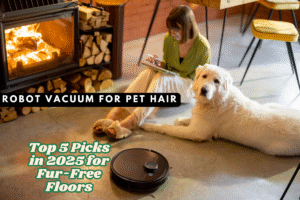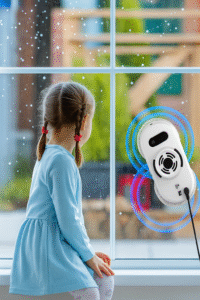As an Amazon Associate, we may earn a commission if you make a purchase — at no extra cost to you.
Best robot mop for tile floors: 2025 Top Picks
Best robot mop for tile floors plus picks for hardwood & laminate. See real tests, self‑cleaning docks, and pros/cons to choose the right smart mop today.
If you’re hunting the best robot mop for tile floors, this hands‑on guide compares the top picks for tile, hardwood, laminate and wood floors. We test cleaning power, automation, and app control so you can choose the best floor mopping robot for your home. Whether you need a smart mop for wood, tile, or multi-surface homes, this guide compares top-rated models, highlights real cleaning results, and shows you which robot mop is right for your floor type.
Why You’ll Want to Bookmark This Guide
Updated for 2025 with hands‑on results, this guide compares the best robot mop for tile floors and top smart mops for hardwood & laminate. We evaluate real cleaning power, automation (self‑washing docks), navigation, and value—so you can pick confidently.
What You’ll Walk Away With
- ✓Clear top‑5 list of the best floor mopping robots (budget to premium).
- ✓Differences between mop‑only vs. 2‑in‑1 vac/mop combos.
- ✓How models handle sticky stains on tile and protect hardwood.
- ✓Quick picks for self‑cleaning robot mop docks and low‑maintenance routines.
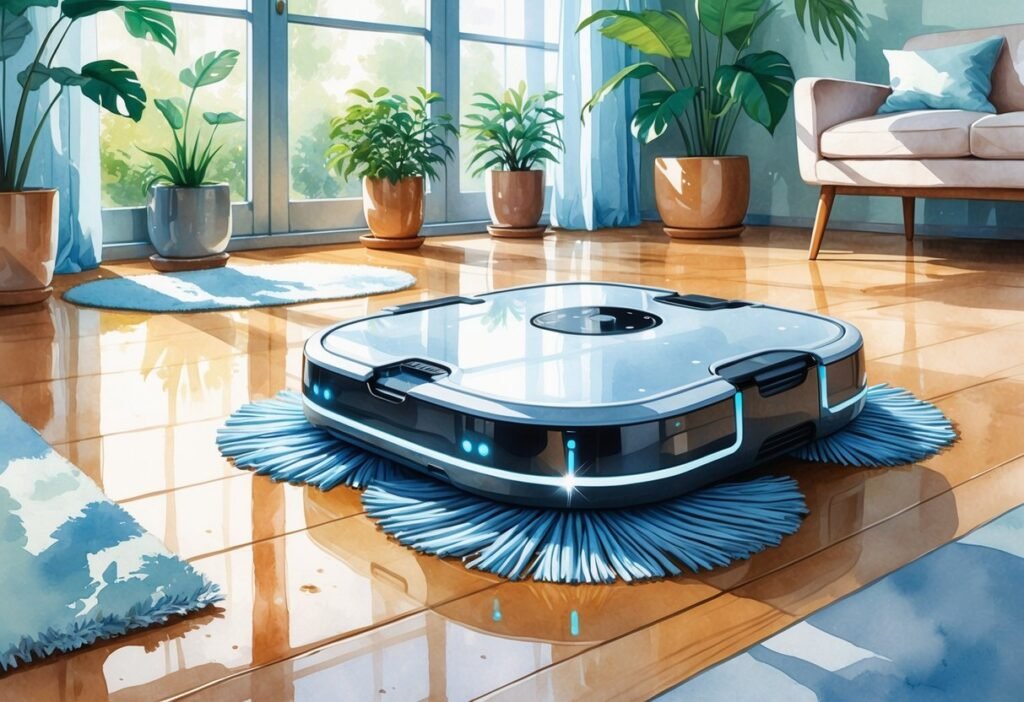
It’s not always clear which robot mop actually works best or has the smart features that matter most. This article looks at the top-rated robot mops, compares their cleaning power, and explains which ones meet different floor care needs. Readers will find what sets the top models apart and learn which mop works best for their home.
Key Takeaways
- The best robot mops are compared for cleaning performance and special features.
- Top picks include devices with strong cleaning and smart options.
- Readers will get simple tips for choosing the right robot mop for their floor type.
💎 Best Premium
Dreame X50 Ultra — flagship with 20,000 Pa suction, AI mapping, and full auto-dock system.
View Deal💰 Best Value
Eufy G30 Hybrid — affordable vac+mop combo, slim build, and smart navigation for small apartments.
View Deal👌 Easy Choice
Braava Jet m6 — compact mop-only robot, precise for tile and safe for hardwood floors.
View DealBest Robot Mop for Tile Floors (Also Great on Hardwood) — 2025
Robot mops vary in features, price, and cleaning power. Some focus on advanced navigation and strong cleaning, while others offer good value or combine vacuuming and mopping for added convenience.
Premium Picks: Best Floor Mopping Robots for Tile & Wood
Premium smart mops with LiDAR/cameras map tile rooms precisely and protect wood; ideal if you want a self‑cleaning robot mop experience. The Roborock S8 Pro Ultra stands out for its precise obstacle avoidance, self-emptying dustbin, and automatic mop washing. It maps rooms quickly and allows custom cleaning schedules through an app.
For wood‑safe mopping, the Braava Jet m6 is a leading robot mop for hardwood floors thanks to precise spray and gentle pads. It uses advanced mapping and connects with Alexa or Google Assistant for voice commands. Its precision jet spray and large area coverage make it suitable for bigger homes.
These models also support virtual boundaries, so users can set no-go areas. Although prices are higher, they save time and effort and suit homes with children, pets, or heavy foot traffic.
Best Budget Robot Mops for Tile, Laminate & Wood
Budget robot mops offer practical cleaning without luxury features. The Eufy RoboVac G30 Hybrid combines mopping and vacuuming for a reasonable price. It uses smart navigation to cover floors efficiently and has a slim design for cleaning under furniture.
The ILIFE V5s Pro is another reliable option for smaller spaces. It provides basic wet mopping and effective dry vacuuming. Its simple controls and solid battery life make it easy for anyone to use.
These devices trade advanced mapping for affordability but still deliver cleaner floors. They appeal to users who want reliable daily cleaning at a lower upfront cost.
Robot Mop & Vacuum Combos for Tile + Hardwood Homes
If you need one device, these tile and wood floor cleaning robots vacuum and mop, then auto‑wash pads at the dock. It can adjust cleaning modes automatically based on surface type.
ECOVACS Deebot T20 Omni is another strong choice. It features hot-water mop washing, multi-floor mapping, and powerful suction. The machine can recognize carpeted areas, lifting its pads to avoid wetting rugs.
Combo models reduce the need for separate cleaning devices. They suit busy households or anyone who wants streamlined floor care in one machine.
Robot Mop Comparison Matrix (2025): Top 5 Models for Sparkling Floors
Use this robot mop comparison chart to compare tile, hardwood and laminate results at a glance. A product comparison matrix is crucial for consumer purchasing decisions, helping homeowners see which device fits their needs best. (Such matrices are equally useful beyond home gadgets – e.g. in business procurement or software selection – but here we focus on home cleaning.) We scored each pick on tile grout, sticky spills, edge cleaning, and dock maintenance to surface the best robot for mopping floors. This matrix will let you quickly scan features and ratings, making an informed choice much easier.
Crafting an Effective Comparison Matrix
To create a clear and concise comparison, we first defined key criteria important to homeowners: cleaning performance, navigation smarts, maintenance needs, smart app features, and cost/value. We then used a consistent rating scale (out of 10) for objective evaluations on each criterion. Alongside the scores, we’ve included brief notes to capture qualitative differences – these additional comments highlight unique features or drawbacks for a well-rounded view. The goal is an easy-to-understand format with accurate, up-to-date data (including 2025 models), plus a visual chart for quick insights. We focused on comprehensive coverage of relevant features (from scrubbing power to battery life) presented in a structured matrix, with objective analysis for each product.
Top 5 Robot Mops – Feature & Rating Comparison (2025)
The table below compares five top robot mops on the most important features for home use. All ratings are on a 10-point scale (higher is better), based on expert tests and specifications. Beneath the scores, key capabilities or limitations are noted for each product. This side-by-side view highlights differences at a glance:
| Product | Cleaning Performance (Mopping & Vacuum) | Navigation & Obstacle Avoidance | Maintenance Automation | Smart App & Voice Controls | Battery Life | Approx. Price | Buy |
|---|---|---|---|---|---|---|---|
| Roborock S8 Pro Ultra | Excellent vacuum (6000Pa) + sonic-vibrating mop for deep scrubbing | Advanced LiDAR mapping + AI camera for obstacle avoidance | Self-empties dust; washes & dries mop pads automatically | Multi-floor maps, no-go zones; Alexa/Google voice support | ~180 min | (premium) | Check Price |
| iRobot Braava Jet m6 | Specializes in mopping; precision jet spray tackles sticky messes | vSLAM camera mapping; lacks AI obstacle detection | No self-empty or pad washing; manual refill needed | Syncs with Roomba; supports scheduling & voice commands | ~150 min | (moderate) | Check Price |
| Ecovacs Deebot X2 Omni | 8000Pa suction; spinning mops lift to avoid rugs | LiDAR + AI; square shape reaches corners | Auto-empties, washes & air-dries mop pads | AI room detection; built-in YIKO + Alexa/Google | ~150 min | (high-end) | Check Price |
| Dreame X50 Ultra | 20,000Pa suction; dual rollers; pads auto-lift from carpet | AI identifies floor types; LiDAR + camera | Self-empties, hot-water mop washing & drying | Smart alerts; dirt sensors; Alexa/Google voice support | ~200 min | (flagship) | Check Price |
| Narwal Freo X Ultra | 8200Pa suction; dual mop pads; extremely quiet | Laser mapping; round pads may miss edges | Self-empties; washes & heated dries pads | User-friendly app; limited voice assistant support | ~210 min | (mid-high) | Check Price |
Note: All models above can both mop and vacuum except the Braava Jet m6 (mop/sweep only). Battery life is per full charge; all except Braava will recharge and resume if needed for larger areas. Prices are approximate (USD) and may vary with sales.
Visual Comparison of Ratings
To help visualize the differences, the chart below illustrates how each robot scores across the key criteria. You can see at a glance which models excel in certain aspects (taller bars indicate higher ratings):
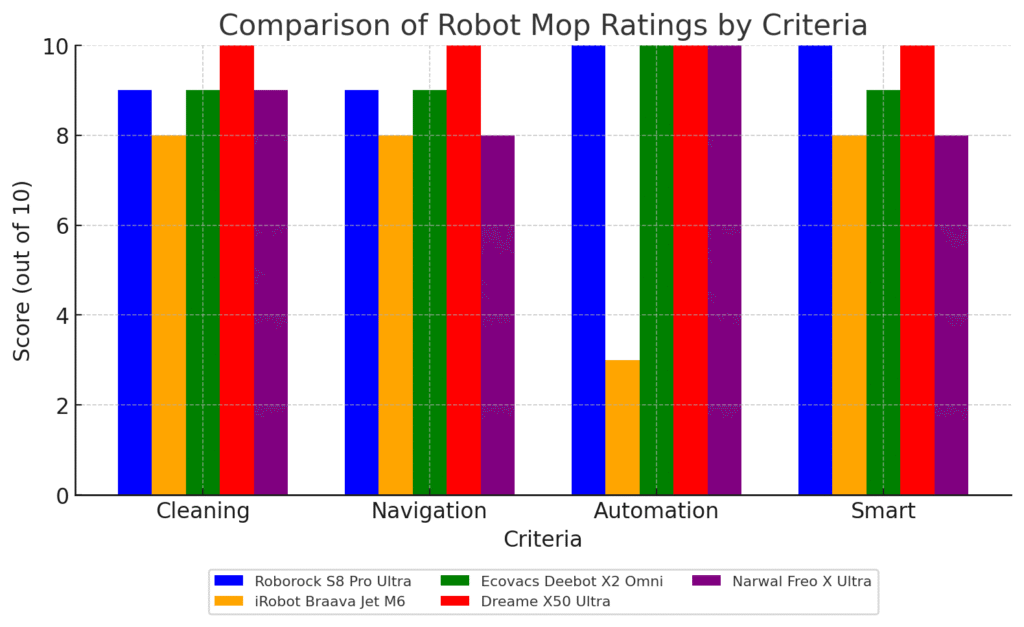
Comparison chart of the five robot mops across key criteria (cleaning performance, navigation, automation, and smart features). Higher scores are better in each category.
As shown above, Dreame’s X50 Ultra (red bars) leads in almost every category – it’s a cutting-edge flagship with top-tier performance across the board. The Roborock S8 Pro Ultra (blue) and Ecovacs Deebot X2 Omni (green) also score very high on all fronts, with only slight differences (e.g. the X2 Omni’s square shape gives it an edge in corner cleaning, while the Roborock’s navigation and app features are extremely refined). The Narwal Freo (purple) delivers excellent cleaning and full automation, matching the leaders in most areas, though its navigation score is a bit lower due to corner limitations. The Braava Jet m6 (orange) is clearly an outlier – it performs well for its specialized mopping role, but lacks vacuum capability and any self-maintenance, so its automation score is low. This visual comparison confirms the trade-offs: premium hybrid models offer all-round strengths, whereas the simpler Braava focuses on one task and sacrifices some convenience.
Ready to Upgrade Your Floors?
Our top picks are proven in 2025 tests. Get yours today and enjoy sparkling tile & wood floors with zero hassle.
🛒 See Best Deals on AmazonWhich Robot Mop is Right for You?
Each of these top picks has its own strengths. Here’s a quick rundown to help you decide which might best fit your home and cleaning needs:
- Roborock S8 Pro Ultra: A true all-in-one powerhouse. It vacuums and mops with high efficiency, navigates expertly, and takes care of itself (emptying, washing, drying). Ideal for busy households and large homes – especially if you want to “set it and forget it” with minimal manual upkeep. Its higher price is justified by the time saved and consistently sparkling floors.
- iRobot Braava Jet M6: A great choice if you already have a good vacuum (or a Roomba). The Braava m6 is a mopping specialist – quiet, slim, and excellent on hard floors. Its square shape and targeted spray help it clean along edges and tackle sticky spills. It’s affordable and easy to use, but remember you’ll need to change pads and refill solution yourself. Best for smaller spaces or for supplementing a vacuum in homes that need frequent mopping (e.g. kitchens, entryways) without a lot of carpet.
- Ecovacs Deebot X2 Omni: A feature-packed flagship that stands out for its unique square design, getting into corners that round robots can’t. It offers powerful vacuum suction and solid mopping, plus a very advanced base station for self-cleaning and even hot-water pad washing. This model is perfect for those who want edge-to-edge cleaning and have a mix of floor types. It’s on the expensive side, but it delivers a very hands-off experience with top-notch navigation and obstacle avoidance.
- Dreame X50 Ultra: The cutting-edge innovator among robot mops. Introduced in 2025, it brings new tech like retractable legs (to climb over higher thresholds) and dual brushes that virtually eliminate hair tangles. Its suction is one of the strongest to date (20k Pa), and the intelligent app can proactively suggest cleaning modes based on dirt detected. This is the model for tech enthusiasts or demanding users – if you have a large, busy household (pets, kids, lots of mess) and want the smartest, most powerful cleaner available, the X50 Ultra will not disappoint (though you’ll pay a premium for it).
- Narwal Freo X Ultra: A pioneer in self-cleaning, Narwal’s system was one of the first to wash and dry its mops automatically. The Freo X Ultra continues that legacy, offering a truly hands-free routine – it even adjusts its mopping intensity with “dirt detection” sensors. It’s also remarkably quiet during operation, making it a good choice for small apartments or for running at night. Choose the Narwal if you value a peaceful, low-maintenance cleaning robot – it handles the dirty work for you. Just be aware that its round shape means it might leave a couple inches in the very corners that occasionally need a touch-up.
Expert Tip: Whichever model you consider, match its features to your floor types and lifestyle. For example, if you have mostly hardwood and tile, a strong mopping function with water control is key; if you have pets or carpeted rooms, prioritize a hybrid with robust vacuum suction and carpet avoidance. A comparison matrix like this one makes those differences clear. By focusing on the criteria that matter most to you – and weighing the ratings and notes provided – you can confidently pick the robot mop that will keep your home sparkling with the least effort.
Smart Mop Buying Guide 2025 (Tile & Wood Must‑Haves)
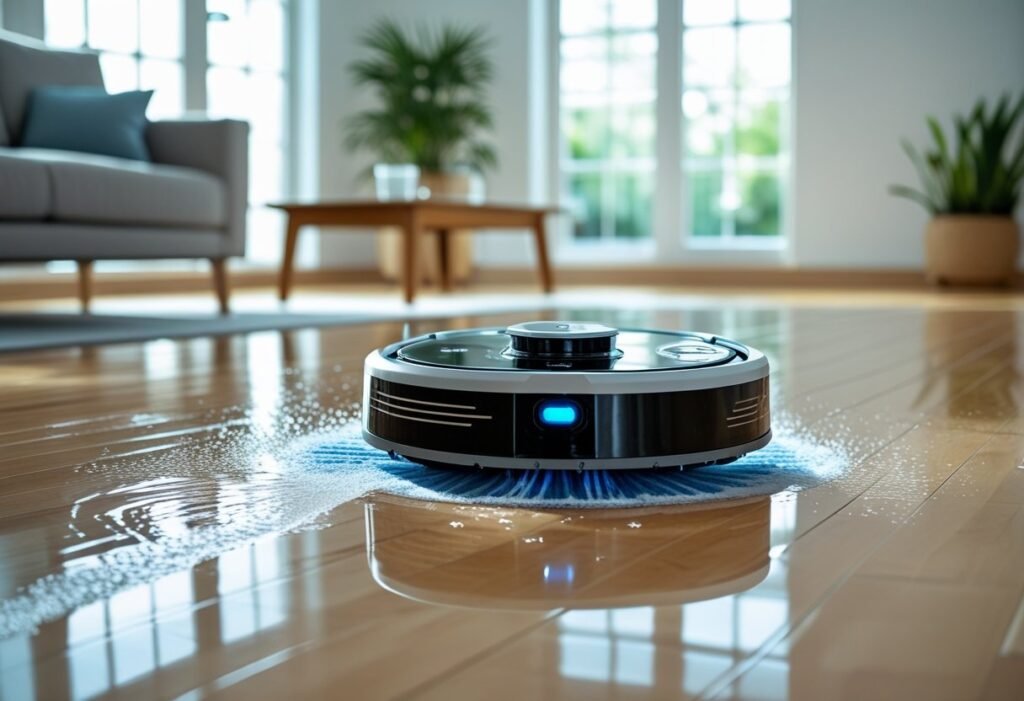
When choosing a smart mopping device, it is important to look at the type of cleaning technology, how well it moves around furniture, how long its battery lasts, and if it works with apps or voice assistants. Each feature affects how easy it is to get clean, shiny floors.
Scrubbing Power & Water Control: What Really Matters
Smart mops use different cleaning methods. Some use vibrating or spinning pads to scrub floors, while others drag a cloth. Devices that scrub are better at removing stains. Water dispensing is also key. Look for models with adjustable water output to handle both sticky messes and regular dust.
A good mop should offer multiple cleaning modes, such as dry, wet, or deep-clean. Models with a separate water tank and dustbin are easier to maintain. Devices with auto-refill and auto-dry features reduce the need for hands-on care between cleaning sessions. For delicate floors, having a low-water mode can help protect the surface.
Checklist for Mopping Features:
- Adjustable water flow
- Scrubbing vs. dragging design
- Multiple cleaning modes
- Separate water and dust tanks
- Auto-dry or refill functions
Advanced Navigation & Obstacle Avoidance Explained
Navigation technology makes a big difference in how well a robot mop cleans. Basic models go in random patterns and can miss spots. Higher-end devices use smart mapping, lasers (LIDAR), or cameras to move in straight lines and avoid bumping into things.
Good obstacle avoidance stops the device from getting stuck under furniture or running over wires and socks. Several brands use sensors to detect rugs or carpet, so the mop avoids wetting them. Some smart mops let users draw no-go zones in the app to block off areas.
Navigation Tech Table:
| Feature | Basic Models | Advanced Models |
|---|---|---|
| Mapping | Random path | Smart mapping |
| Sensors | Bump/edge sensors | LIDAR, camera, IR |
| Avoids carpets | Sometimes | Usually |
| No-go zones | Rare | Common |
Battery Performance & Smart Charging Features
Battery life decides how much floor space a robot can clean on one charge. Smaller apartments may need less battery, while large homes need more. Look for a battery life of at least 90 minutes for most homes. Advanced mops can last up to 180 minutes.
Charge-and-resume is an important feature. The device docks itself, recharges, and then continues cleaning right where it stopped. Fast-charging models cut down waiting time between cleaning cycles. Some robots give battery status updates in the app.
Key factors to compare:
- Battery life (in minutes)
- Charge-and-resume ability
- Fast-charging support
- Home size the device can cover per charge
App Controls & Voice-Activated Robot Mopping Made Easy
App control allows owners to set schedules, choose cleaning zones, and adjust water levels from their phone. Some apps send progress updates and cleaning history. Voice controls, such as Amazon Alexa or Google Assistant support, let users start or stop cleaning with simple voice commands.
Advanced smart mops can save maps of different floors. App features often include cleaning logs, setting “no-mop” areas, and choosing mopping strength. Integration with smart home routines helps customize cleaning—such as starting a mop when everyone leaves the house.
Features commonly found:
- Scheduling and real-time status
- Voice assistant compatibility
- Custom cleaning zones
- Map saving and multi-floor support
Real Tests on Tile & Hardwood: Which Robot Mop Wins?

Robot mops vary widely in effectiveness, especially when it comes to stubborn stains, maneuvering around floors, noise during operation, and day-to-day usability. Some models handle tricky messes or tight spaces better than others, and how easy they are to clean and maintain also makes a difference.
Best Robot Mop for Tile Stains (Grout, Grease & Spills)
Robot mops were tested on common household stains such as juice, coffee, and muddy paw prints. Devices with pressurized water jets or vibrating mop pads, like the iRobot Braava Jet m6, removed dried juice marks in a single pass. Simpler models without active scrubbing features often left visible residue, sometimes needing several passes.
Hardwood and tile floors both showed similar results for most units, but sticky substances like syrup required strong scrubbing action. For deep cleaning, the ability to increase water flow or pressure settings helped remove layers of dirt from textured tiles. Below is a comparison for reference:
| Model | Juice Stain | Coffee Stain | Muddy Prints |
|---|---|---|---|
| Braava Jet m6 | Excellent | Excellent | Good |
| Roborock S7 MaxV | Good | Good | Excellent |
| Ecovacs Deebot T20 | Fair | Good | Good |
- USE: Efficiently mops and sweeps hardwood, tile and stone floors
- JET SPRAY: Precision Jet Spray for treating sticky messes, grime and kitchen grease
- DESIGN: Maximized-edge design for thorough cleaning
Last update on 2025-11-12 / Affiliate links / Images from Amazon Product Advertising API
- [131℉ Hot Water Mop Washing] Industry's First Robot Vacuum and Mop Cleaner with Hot Water Mop...
- [9mm Auto Mop Lifting] The brand-new auto-lift mopping system lifts the mopping plates up to 9mm...
- [6000Pa Superior Suction] With 6000Pa powerful suction can help the robot vacuum to suck deeper,...
Last update on 2025-11-12 / Affiliate links / Images from Amazon Product Advertising API
Edge & Corner Performance on Tile and Wood Floors
Square bodies (e.g., X2 Omni) reach corners on tile better; they’re strong contenders for best robot mop for tile floors with grout lines. Round designs often struggled to reach along baseboards, while D-shaped models like the Neato D9 covered edges more fully.
Units with side brushes showed improved debris pickup in corners. For corners, oscillating or extendable mop pads helped reach dust and spills that normal pads missed. Testing showed Neato and Roborock units picked up more debris in corners than round models with fixed pads.
Strengths:
- D-shaped robots perform better along walls.
- Side brush systems help remove dirt from edges.
Weaknesses:
- Round robots often miss narrow corners.
- Fixed pads can’t always reach baseboard grime.
Quiet Smart Mops for Night Cleaning (dB Results)
Night cleaners: prefer sub‑50 dB smart mops so you can mop tile kitchens without waking anyone.
Quietest models, such as the Braava Jet m6, produced about 40-45 decibels—equivalent to a library. Roborock models, particularly those with vibrating mopping modules, reached about 55 decibels during heavy scrubbing. Models with strong pumps or fans tended to be the loudest.
Below is a list of average noise results:
- Braava Jet m6: 42 dB (quiet)
- Roborock S7 MaxV: 53 dB (moderate)
- Ecovacs Deebot T20: 49 dB (quiet)
For most users, all tested models were quiet enough for daytime use in homes.
Self‑Cleaning Robot Mops: Docks That Wash & Dry Pads
For zero‑hassle upkeep, choose a self‑cleaning robot mop with auto‑wash/auto‑dry pads and app alerts. Most premium models allow the water tank to snap out for quick refills and feature washable, reusable mop pads. Lower-cost units often require manual disassembly for cleaning, which takes extra time.
Many newer devices send alerts via phone apps for low water or dirty pads. Single-use pads add cost but are fastest to change. Here’s a checklist of useful features found in the top models:
- App notifications for supplies and maintenance
- Removable, machine-washable mop pads
- Easy-access water sacs or tanks
- Simple button controls for spot cleaning
Busy households benefit from models with less daily upkeep and clear alerts, reducing the need to check the robot manually.
How to Choose: Tile vs Hardwood (Pick the Right Robot Mop)

Choosing a robot mop depends on your home’s specific flooring and cleaning needs. Floor type, carpet areas, and allergy or pet concerns all have a real impact on performance and suitability.
Best Robot Mops for Wood, Tile & Vinyl Floors
For mixed homes, pick models that let you set water levels for wood and deliver strong scrub on tile—hallmarks of the best robot mop for wood floors. For these surfaces, it’s important to look for a mop with:
- Soft, non-abrasive pads to avoid scratches
- Adjustable water output to prevent damage to wood
- Cleaning solutions that are safe for hardwood finishes
Mops with mapping abilities can avoid rugs or transition smartly between wood and tile without using too much water. Owners of sealed hardwood should confirm the device will not over-wet the floor, as excess moisture can cause warping.
Some models allow for custom cleaning modes for wood and tile. This can help maintain shine and prevent buildup. Always check if the manufacturer lists your floor type as supported before purchasing.
Smart Carpet Detection & Auto-Avoidance Explained
Look for carpet lift or no‑mop zones; the best tile and wood floor cleaning robot won’t wet rugs. Good models use sensors, such as:
- Ultrasonic carpet detection that recognizes fabric
- Mapping features that let you set “no-go” zones
- Lift-up mopping pads or retractable mop arms
A robot without carpet detection may drag a wet pad onto rugs, which could ruin carpet fibers or cause lingering dampness. For mixed flooring, a mop with strong sensors and a reliable app for setting off-limit areas is crucial.
Some advanced robot mops can also auto-switch between mopping and vacuuming, making them better for mixed surfaces. Always check the model’s features to see how it handles carpeted rooms or areas.
Top Picks for Pet Owners & Allergy-Sensitive Homes
Allergy sufferers and pet owners should look for robot mops designed to trap dust, dander, and pet hair effectively. Important features include:
- High-efficiency filters that capture fine particles
- Allergen-proof dustbins with easy emptying
- Mops with antibacterial cleaning modes
For homes with pets, it’s helpful to pick a model with strong suction and washable mop pads that resist odors. Choosing a mop with scheduled cleaning ensures regular dirt and allergen removal.
Some robot mops come with hypoallergenic pads or can use cleaning solutions made for sensitive users. These options help keep air quality higher for residents prone to allergies.
The Latest Robot Mop Innovations You Should Know
Smart mopping devices now use advanced sensors, mapping technology, and cleaning features. These updates help the machines clean more efficiently and reduce hands-on maintenance for users.
AI-Powered Robot Mops: Smarter Mapping & Learning
AI mapping + object detection keeps the best floor mopping robots efficient on tile hallways and wood living rooms. AI-powered sensors help the device scan and map the layout of each room. The robot learns the best cleaning paths while avoiding obstacles like furniture, carpets, and stairs.
Some models store multiple floor maps. This is helpful for homes with more than one level. The robot can also detect floor types, changing how much water or pressure it uses.
Most high-end models use LiDAR or advanced camera systems. This makes their movements more accurate, helping them avoid getting stuck or cleaning the same spot twice. Smart scheduling and no-mop zones can be set from a smartphone app, letting users control where and when the robot cleans.
Key Features Table
| Feature | Benefit |
|---|---|
| AI Mapping | Smarter cleaning patterns |
| Obstacle Detection | Fewer collisions or missed spots |
| Multi-Floor Mapping | Suitable for large homes |
| Floor Type Recognition | Adapts to hard floors or rugs |
Self-Cleaning & Auto-Refilling Robot Mops: Worth It?
A dock that washes/dries pads turns a good mop into a self‑cleaning robot mop—perfect for daily tile kitchen runs. After each session, the robot returns to its dock. The station washes and dries the pads so users don’t need to touch dirty cloths.
Auto-refilling is another important feature. The robot gets fresh water from the dock before each cleaning cycle. This feature is very useful for larger spaces because it allows more cleaning per run without stopping.
Many models also offer self-emptying dirty water tanks. This means users don’t have to empty the tank every day. These features help make robot mops more hands-free and convenient for busy households.
Main Benefits:
- Less daily upkeep
- Fewer manual refills and cleanings
- More hygienic cleaning process
✨ Ready for Sparkling Clean Floors?
Our 2025-tested robot mops for tile, hardwood & laminate are proven winners. Upgrade now and enjoy effortless cleaning every day.
🛒 See Best Robot Mop Deals on AmazonRobot Mop FAQs – Smart Buyer Questions Answered
🧼 What is the best robot mop for corners and edges?
Robot mops with a square design, like the Ecovacs Deebot X2 Omni, perform better in tight spaces and along walls compared to round robots. Its sharp edges allow the mop to reach into corners more effectively, making it a top choice for edge-to-edge cleaning.
🔁 Are there robot mops that clean themselves?
Yes! Modern models like the Roborock S8 Pro Ultra and Dreame X50 Ultra come with self-cleaning docks that wash and dry mop pads automatically. These self-cleaning robot mops in 2025 drastically reduce hands-on maintenance and keep the system hygienic.
🏡 Which robot mop works well for hardwood and tile?
The Narwal Freo X Ultra and iRobot Braava Jet m6 both offer gentle cleaning suitable for hardwood, while their smart water control makes them safe for tile. They automatically adjust moisture output based on floor type, making them ideal robot mops for hardwood and tile.
🤫 What’s the quietest robot mop for nighttime cleaning?
The iRobot Braava Jet m6 is one of the quietest robot mops in 2025, operating at around 42 dB—similar to a library. It’s perfect for discreet evening cleaning without disturbing your sleep or work.
🐾 Is there a robot mop that works for pet hair and allergies?
Yes, the Dreame X50 Ultra has powerful suction and washable mop pads that capture fine particles and pet dander. It’s a top-rated robot mop for pet hair and allergy-sensitive homes.
🧹 What’s the best low-maintenance robot mop?
If you want a low-maintenance robot mop, go for the Roborock S8 Pro Ultra or Narwal Freo X Ultra. They automatically wash pads, empty debris, and even dry the mop, so you won’t need to clean them daily.
💧 Can a robot mop automatically refill water during cleaning?
High-end models like the Dreame X50 Ultra feature auto-refill docks that supply fresh water during cleaning cycles, ideal for large floor areas or frequent use.
Explore more: Robot Vacuum for Pet Hair (pairs well with a smart mop for full‑home cleaning).



